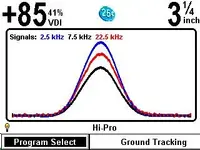OBXmetalDet
Full Member
- Joined
- Aug 25, 2019
- Messages
- 111
- Reaction score
- 65
- Golden Thread
- 0
- Detector(s) used
- Minelab Equinox 800
- Primary Interest:
- All Treasure Hunting
- #1
Thread Owner
Hi,
I have a few questions.
1. Suppose I use a single frequency of 20kHz. If I do that, would I be able to detect only certain metals or would the detector still pick up all metals? If it would still pick up all metals, would the signals from some of those
metals be weaker (quieter) than other metals?
2. What exactly is threshold? What exactly are you filtering out?
3. When you increase/decrease the sensitivity, what exactly is being changed? Are you making changes in the frequency or something else?
4. In the attached signal response graph, what are the units on the X and Y axis?
I have a few questions.
1. Suppose I use a single frequency of 20kHz. If I do that, would I be able to detect only certain metals or would the detector still pick up all metals? If it would still pick up all metals, would the signals from some of those
metals be weaker (quieter) than other metals?
2. What exactly is threshold? What exactly are you filtering out?
3. When you increase/decrease the sensitivity, what exactly is being changed? Are you making changes in the frequency or something else?
4. In the attached signal response graph, what are the units on the X and Y axis?




